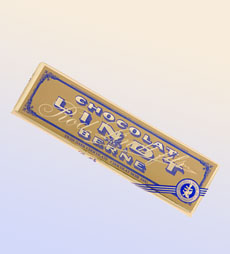
A single origin bar from the master of single origin cacao, Michel Cluizel. This bar is made with beans from the Los Anconès plantation on the island of Santo Domingo, and is one of the greatest chocolate bars in the world. Read our review of Michel Cluizel chocolate, a NIBBLE Top Pick Of The Week. Photo by Melody Lan | THE NIBBLE.
Last Updated May 2018 |
Product Reviews / Main Nibbles / ChocolateChocolate GlossaryChocolate Terms & Definitions: S
Here you’ll find terms including semisweet chocolate, single origin chocolate and Swiss chocolate. If you think we should consider chocolate terms and definitions other than those we have provided click on the Contact Us link on this page. Also enjoy our other 60 food glossaries. Use this index bar to visit other pages. a b c d e f g h i j k l m n o p q r s t u v w x y z This glossary is protected by copyright and cannot be reproduced in whole or part. SÃO TOMÉAn island republic in the Gulf of Guinea off the west coast of Africa, that is a prime growing area for the Amelonado subspecies of high quality Forastero. São Tomé cacao can be bitter with flavors of pure cocoa, sharp red fruits, cinnamon, and vanilla. It is a good base for blended chocolate. SHELF-LIFESee storage. SHELL MOLDINGSee molding. SINGLE ESTATE CHOCOLATEChocolate created with beans from one particular estate, plantation or hacienda (these terms are interchangeable). Single estate does not necessarily mean only a single variety of beans is used in the chocolate: It can be a blend (e.g. Criollo and Forastero) or a single variety of beans, as long as the beans come from the same estate. SINGLE ORIGIN or ORIGIN CACAO or PURE ORIGIN CACAO or MONORIGIN CACAOBeans grown in one particular area or region,or the chocolate made from these beans (which can be called called single origin chocolate). This can either be a blend (e.g. Criollo and Forastero) or a single variety of beans. In fact, the origin of the bean can be a more important flavor determinant than the species of the bean (Criollo, Forastero or Trinitario). Seek to identify flavors of chocolate by the origin of its beans (Costa Rica, Madagascar or Venezuela, e.g.) rather than by whether it is Criollo- or Forastero-based. See also grand cru and premier cru. SINGLE ORIGIN CHOCOLATESee above. SNAPThe clear, crisp sound made from breaking a piece of chocolate from a bar. A good, clean snap is indicative of high cacao content and well-tempered chocolate. Milk chocolate which has lower levels of cocoa solids, and white chocolate which has no cocoa solids and is softer, don’t have the same clean snap (the higher the cacao content, the harder the chocolate). The opposite of snap is crumbly. SOYA LECITHINLecithin extracted from soybeans. Soy, not egg lecithin, is used in the manufacture of chocolate. It increases the pliability of the chocolate. See lecithin. STORAGETop chocolatiers are concerned about the freshness of their product, and recommend that chocolate bars be consumed within three to six months after production. However, while they will not be as perfect as if consumed within six months, dark chocolate bars can be kept for two years or more if stored properly—well wrapped in foil in a cool, dark, dry place. A wine cellar is the ideal location because of its temperature and humidity. Milk and white chocolate have a more limited storage time, but will stay fresh for a year or more under these conditions. Filled chocolates, chocolates with nuts and other additives (including bars) have less of a shelf life because the additives will break down or go rancid. Commercial companies will use preservatives to extend the shelf-life, but most fine chocolates are made preservative-free. A box of fine filled chocolates or truffles should be consumed within two weeks, the sooner the better. The fillings, creams, and purées with which they are made deteriorate quickly: To enjoy them, they should be eaten soon after they are made. If you have a question about the shelf-life, call the chocolatier. SUGAR BLOOMSugar bloom is generally the result of a temperature shock—most often, storing chocolate in the refrigerator (which should not be done) and removing it to serve. When the chocolate is taken out of the refrigerator and condensation collects, a rough irregular texture forms on top of the chocolate. This is the sugar bloom. The condensation dissolves the sugar in the chocolate; when the water evaporates, the sugar recrystallizes into rough, irregular crystals on the surface which gives the chocolate an unattractive appearance. If chocolate has been stored in a cold place, allow it to come to room temperature slowly before opening the package, thus minimizing the condensation. Bars with sugar bloom can be re-melted and re-tempered, or used in baking or in sauces where the texture is not a factor. Bonbons with sugar bloom cannot be restored. SUR DEL LAGOSur Del Lago is one of the two distinct cacao growing regions of Venezuela (the other is Andean). It produces beans called Sur Del Lago Clasificado, a mixture of Criollo and Trinitario. This cacao is hearty and robust, and bears an extreme dark tone with flavors of butter, hazelnuts, and red fruits plus floral tones. SWEET CHOCOLATESweet chocolate is a cooking and baking chocolate. It is made by mixing chocolate liquor with sugar and extra cocoa butter. SWEETENERFine chocolate is sweetened with cane sugar. Mass-produced chocolate can substitute high-fructose corn syrup. Fine chocolates labeled “sugar free” generally use maltitol, where mass-distributed chocolates can use saccharine, sorbitol or other less expensive sweeteners. See our article on sweeteners. SWISS-STYLE CHOCOLATEOf the three styles of bonbons—Belgian, French and Swiss—Swiss chocolates are the most creamy, smooth, soft and velvety and have a greater focus on milk chocolate. This is based on the heritage of the Swiss chocolate. In 1879, Daniel Peter, a Swiss chocolate manufacturer, successfully created milk chocolate by substituting powdered milk for the whole milk or cream that had been unsuccessfully used previously. In that same year, another chocolate manufacturer, Rodolphe Lindt, invented conching, the process that makes chocolate smoother and more velvety. And, the quality of the milk used in Swiss chocolate, which comes from alpine cows, contributes its own creaminess. Continue To Next Page: Terms With T
Lifestyle Direct, Inc. All rights reserved. Images are the copyright of their respective owners.
|
Last Updated May 2018
© Copyright 2005-2025 Lifestyle Direct, Inc. All rights reserved. All images are copyrighted to their respective owners.

